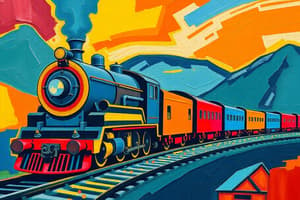Podcast
Questions and Answers
What was the significance of the Transcontinental Railroad?
What was the significance of the Transcontinental Railroad?
- It linked the eastern and western railroad systems
- It decreased transportation costs
- It led to the destruction of Native American lands
- All of the above (correct)
What year was the Transcontinental Railroad completed?
What year was the Transcontinental Railroad completed?
1869
What was Union Pacific's role in the transcontinental railroad?
What was Union Pacific's role in the transcontinental railroad?
It built westward from Omaha
What scandal was associated with Credit Mobilier?
What scandal was associated with Credit Mobilier?
Where did the Central Pacific Railroad start?
Where did the Central Pacific Railroad start?
Which of the following contributed to the Second Industrial Revolution?
Which of the following contributed to the Second Industrial Revolution?
What did the Supreme Court rule in Wabash v Illinois?
What did the Supreme Court rule in Wabash v Illinois?
What was the purpose of the Interstate Commerce Commission?
What was the purpose of the Interstate Commerce Commission?
What was the outcome of the Slaughterhouse Cases?
What was the outcome of the Slaughterhouse Cases?
What was the Grange movement?
What was the Grange movement?
Flashcards are hidden until you start studying
Study Notes
Transcontinental Railroad
- Completed in 1869 at Promontory, Utah, linking eastern and California railroad systems.
- Revolutionized transportation by facilitating faster and cheaper travel for mail and goods.
- Involved displacement and violence against Native Americans during construction.
Union Pacific
- Initiated in Omaha during the mid-1860s, built westward as part of the transcontinental railroad.
- Key player in the connection of the nation through rail infrastructure.
Credit Mobilier
- An 1867-1868 scandal involving Union Pacific executives who formed a construction company.
- Executives overpaid themselves for building the railroad, leading to significant corruption issues.
Central Pacific Railroad
- Launched in California, extending eastward to meet the Union Pacific at Promontory Point, Utah.
- Constructed 1,086 miles of railroad primarily by ex-soldiers, former slaves, and immigrant labor (Irish and German).
- Faced challenges including poor road conditions, extreme weather, and conflicts with Native Americans.
Causes of Second Industrial Revolution
- Driven by natural resources such as coal, oil, iron ore, copper, lead, and timber.
- An influx of immigrant labor, laissez-faire government policies, and new power sources like electricity and petroleum.
- Railroads played a crucial role in industrial growth along with numerous inventions by American inventors.
Second Industrial Revolution
- Spanning the late 19th century post-Civil War, marked a shift from agrarian to industrial society.
- Significant growth in heavy industry, steel production, petroleum, electric power, and industrial machinery.
Wabash v Illinois
- Supreme Court ruling prohibiting states from regulating railroads under the Constitution's interstate commerce clause.
- Shifted regulatory focus to the federal government, which gained exclusive control over the railroad industry.
Interstate Commerce Commission
- Established as a federal regulatory agency to stabilize the railroad industry and prevent destructive competition.
- Served as a tool for rail companies to navigate economic challenges.
Slaughterhouse Cases
- A pivotal 1873 Supreme Court decision interpreting the Fourteenth Amendment.
- Limited "privileges and immunities" of citizens to those explicitly stated in the Constitution, allowing states to grant monopolies without constitutional infringement.
Grange
- A farmers' movement encouraging local farmers to unite for political and economic benefits.
- Officially known as the Patrons of Husbandry, successful in regulating railroads and grain warehouses.
Studying That Suits You
Use AI to generate personalized quizzes and flashcards to suit your learning preferences.




